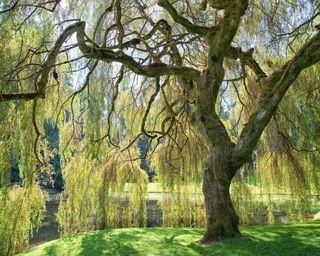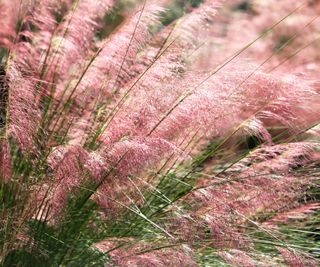As attractive natural features, trees can contribute hugely to a property’s curb appeal. Indeed, there are many trees that will add value to your home. However, when planted thoughtlessly, they can cause a real headache when it’s time to sell up and move on.
It’s not always the tree’s fault – some of America’s most iconic trees are just not suitable for planting close to a house. An oak tree, for example, may be prized when planted in a large open space. But if close enough for its roots to wreak havoc with foundations and hardscaping, it will prove a turn-off for buyers.
Which Trees Devalue A House?
The culprits most likely to take a chunk out of your house’s value are trees with aggressive roots that can damage paving and sidewalks, and disrupt the stability of building foundations. However, many buyers will also be on the lookout for invasive trees in gardens that pop up everywhere like weeds, making them difficult – and expensive – to control.
Even where a tree isn’t invasive, bad-smelling or messy trees can be enough to make buyers run for the hills.
Happily, most trees will prove a valuable addition to the landscape. But it’s important to do your research when choosing a tree. Check that your preferred option is suitable for your USDA planting zone, does not have aggressive roots or invasive spreading tendencies, and has maintenance needs that are compatible with your lifestyle. It’s also vital that the tree’s mature height and spread, and planting distances are considered and respected.
Discover the trees that you should think twice about planting in your yard.
1. Weeping Willow
(Image credit: Getty Images)
Though one of the most romantic and evocative of trees, the weeping willow is infamous for its invasive roots. Spreading a distance of around three times the tree’s height, the aggressive and shallow roots shoot out in all directions in search of water. They are attracted to sewer drains, septic systems, and main water lines, and can do damage to pipework.
Suitable for USDA zones 4 to 10, weeping willow is a thirsty tree and its roots suck a lot of water out of the soil. If planted too close to the house, the tree can even cause structural issues such as subsidence.
To add to this, the tree’s wood is weak, and so branches are prone to breaking off in a storm.
If you have a large enough property and can plant a weeping willow tree far away from the house, close to a body of water, and not near any pipework, then you should be fine to plant. However, when planted in smaller yards or too close to the house, they will be a red flag for most buyers.
2. Bradford Pear
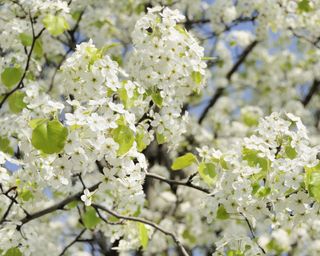
(Image credit: Getty Images)
At first glance, the Bradford pear seems like an attractive landscaping tree. However, it is highly invasive, produces bitter inedible fruit, is prone to breaking in storms, and – perhaps most offputting for potential buyers – smells terrible when in flower (think rotting fish or vomit).
There was a time when the Bradford pear was a popular ornamental tree in USDA zones 5 to 9. Native to Asia, the tree was initially thought to be sterile. However, while incapable of self-pollination, Bradford pears began cross-pollinating with other Pyrus calleryana cultivars.
The resulting seeds were quickly spread by birds who ate the fruit, and new trees grew into undesirable specimens with large thorns.
These trees – known as Callery pears – are extremely hardy and have invaded forests, roadsides, and open fields, where they have crowded out native species. This in turn has negatively impacted local wildlife.
A few states have already banned the Bradford pear – with others looking to follow suit – but it is still widely available in many states. If the tree’s foul smell doesn’t put a chink in your home’s value, then its reputation soon will.
3. Poplars
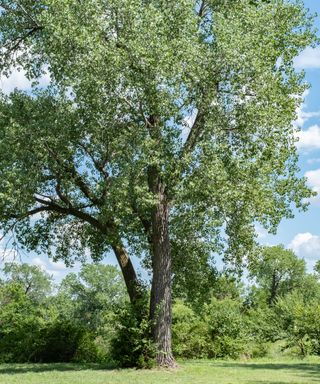
(Image credit: Alamy)
Poplars planted close to a property will raise a red flag for most buyers. Though large impressive trees that grow in USDA zones 3 to 9, poplars have an extensive powerful root system that spreads out two or three times the height of the tree. The roots are capable of lifting sidewalks, patios, and driveways, and will take advantage of any weak areas in sewage lines or basements.
To add to this, the branches are weak and often break in bad weather. Trees are also susceptible to disease and pest infestations.
The cottonwood variety of poplar produces fluffy white seeds that clog AC units, screens, and gutters – and exacerbate seasonal allergies. They also produce a lot of mess in the landscape that is difficult to clean up, and impacts curb appeal.
4. Northern Catalpa
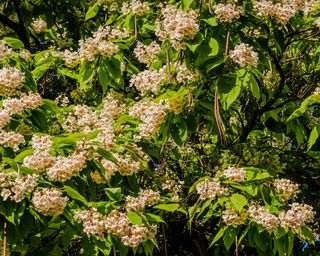
(Image credit: Getty Images)
The Northern catalpa or catawba tree (Catalpa speciosa) won’t necessarily devalue your home, but it will deter some buyers.
It is one of the messiest landscaping trees, shedding leaves all summer, at which point it looks quite ragged. Though pretty, its fluffy white flowers make an unpleasant slimy mess when they drop onto paths or driveways, followed by long, thin seed pods.
One of the biggest turn-offs for many is that the trees are the sole source of food for catalpa worms – which are actually caterpillars. In peak season, your tree will be inhabited by thousands of the critters, who will strip the foliage before coming down onto the ground. The trees usually recover the following year.
However, while many potential buyers won’t want a tree infested with caterpillars, those who enjoy fishing will happily take it off your hands, as catalpa worms make excellent fish bait.
Catalpa trees are fast-growing and can potentially be invasive. Their spread can be managed by raking up seed pods.
5. Tree Of Heaven
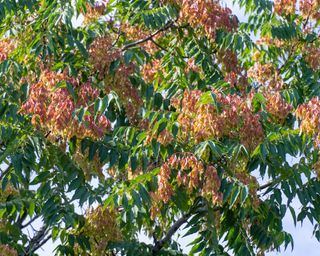
(Image credit: Getty Images)
Despite its inviting name, the tree of heaven (Ailanthus altissima) smells awful – hence its other common name, stink tree. Its smell is often likened to burned peanuts, cat urine, or sweaty gym socks.
As if its horrible smell wasn’t enough to deter buyers, its invasive nature will. Tree of heaven is an imported tree that grows like a weed in USDA zones 4 to 8, developing rapidly through seeds and suckers. Left unchecked, it will quickly multiply and crowd out more desirable native trees. It even emits chemicals from its roots to kill off or limit the growth of nearby plants.
Though the lifespan of trees of heaven is not long, they will easily resprout from their stump. If you cut down a tree, it will resprout and grow at an astounding rate – up to 15 feet (4.5m) per year.
To add to its faults, the tree’s wood is very brittle, so you can expect a substantial loss of branches in storms.
Tree of heaven control is not easy and relies on cutting, burning, and using herbicides.
6. Black Locust
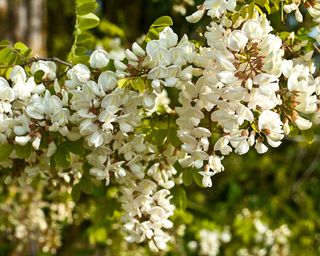
(Image credit: Getty Images)
Unlike many invasive trees, the black locust (Robinia pseudoacacia) is native throughout much of the United States – hardy in USDA zones 4-9. However, it has an aggressive root system and spreads via suckers. Left unchecked the trees can quickly overtake a garden and crowd out other plants.
Chopping down a black locust doesn’t put an end to it. Instead, lots of fast-growing suckers will shoot up on your property and even neighboring yards.
With clusters of fragrant flowers in spring, the black locust at least makes an attractive landscaping feature. However, it produces lots of messy fruit, which takes a lot of cleaning up and can impact a property’s curb appeal.
It’s also a thorny tree that’s susceptible to pests and disease. So while the tree has its admirers, it’s not one to plant if you’re considering selling in the near future.
7. Silk Tree Mimosa
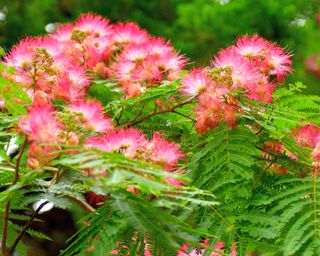
(Image credit: Getty Images)
A short-lived tree with weak wood, silk tree mimosa (Albizia julibrissin) is a highly invasive species that spreads like a weed in USDA zones 6 to 9.
Originally imported from Asia, the silk tree mimosa attracts gardeners with its fragrant fluffy flowers and pretty leaves.
However, the trees produce thousands of seeds annually, which remain viable in the soil for many years. This shedding of flowers and pods can be very messy. When spread by wildlife, the trees quickly establish clumps and crowd out native species.
Once trees have colonized, silk tree mimosa control is difficult as they adapt to most soil types, don’t mind being disturbed, and are unaffected by hot, dry weather.
The only thing that keeps these trees in check is periods of extreme cold, which makes them less problematic in the north.
As silk tree mimosas have a distinctive appearance, it’s easy for potential buyers to spot them on a house viewing – and those in the know are unlikely to meet your asking price.


